China has a splendid costume history, but the splendor of the ancients has gone with the years, and we can only recall it through historical records and archaeological discoveries.
Fortunately, there is someone who can use his exquisite painting skills to rigorously and meticulously restore the ancient Chinese clothing and trace the history of the delicate and gorgeous.
Today, we are going to share with you the ancient Chinese clothing timeline and experience the charm of Chinese clothing together.
Shang Dynasty (c. 16th-11th century BC)
Features: The main feature of the Shang dynasty dress is "upper garment, lower Chang (裳), Youren (右衽), hair bunch". The upper half of the body wears clothes, the lower half of the body wears Chang, Chang is the skirt.
Noble men's dress (left):
- The head wears the tall Ge(葛) cloth crown.
- The Yue-shaped cloth hanging from the front abdomen was a sign of noble status, and was often referred to in later literature as the "Bixi (蔽膝)". The pattern on it is based on the Leiwen depicted on the Shang dynasty Yuge in the collection of the Palace Museum.
- The boots worn by the feet are painted on the basis of pottery boots excavated from the Neolithic site at Ledo, Qinghai.
Yue-shaped: 钺行, tomahawk-shaped;
Yuge: 玉戈, a popular weapon during the Shang Zhou period;
Leiwen: 雷纹, one of the bronze decorations, i.e., a geometric pattern consisting of continuous squiggly lines.
Civilian men's clothing (right):
- A commoner's head is covered only with a hairband made of strands of cloth, and the saw-toothed sickle in his hand is sharpened from pieces of stone.
- During the Shang dynasty, most people wore white clothes, due to the underdeveloped dyeing and weaving techniques and the precious dyes, so most people could only wear clothes made of un-dyed linen material.
Warring States Period (475-221 BC)
Features: During the Spring & Autumn and Warring States periods, the most important changes in clothing were the emergence of the Shenyi (深衣) and the Hu clothing. The Shenyi was a combination of the old "upper garment, lower Chang.
Hu clothing: 胡服, a general term for clothing of foreigners other than Han clothing in ancient time.
Noble men's dress (right):
- The crown is designed after the one worn by the mandarins in the Terracotta Warriors and Horses of Qin Shi Huang.
- The design of the Shenyi is based on the image of the bronze figurine lamp unearthed in Ping Shan, Hebei.
- The belt is based on the pattern of the silk fabric from tomb No.1 of Mashan, Jiangling, Hubei.
Civilian men's clothing (left):
- The Shenyi and topknots of commoner men were designed according to the bronze figures unearthed in Jincun, Henan Province.
- The leather shoes are based on the depiction of a real object unearthed in Changsha, Hunan.
Han Dynasty (206 BC-220 AD)
Features: Shenyi was still popular in the Western Han Dynasty. The trousers, which were learned from nomads, were promoted from warriors to the whole society.
Eastern Han/noble men's dress (right):
- Wearing a Ji robe (罽袍). Ji, in the early Han Dynasty, was a fabric that the emperor expressly forbade the ordinary people to wear. This robe was reconstructed from a tomb unearthed in Yuli Yingpan 15, Xinjiang.
- The lower part is a large-lipped trouser. During the Western Han Dynasty, the Qin Dynasty's large-lipped trousers were called "Dashao (大袑)", but by the Eastern Han Dynasty, the trousers were completely opened, and the style was basically the same as the large-lipped trousers worn by modern women.
Western Han/noble women's dress (left):
- Little finger wearing a gold finger guard, according to the physical depiction unearthed in Laoheshen, Yushu, Jilin, this is the earliest nail sheaths seen so far, indicating that the ancient noblewomen from the Western Han began to have the habit of keeping long nails.
- The Quju silk gown is based on the design of the gown unearthed at Mawangdui, Changsha, Hunan.
North-South Dynasty (420-589)
Features: during the North and South Dynasties, clothing innovation and national integration were synchronized, and Xianbei clothing was popular in North China.
Xianbei: 鲜卑, the Xianbei were an ancient nomadic people who rose to prominence on the Mongolian plateau after the Xiongnu.
Men's clothing (right):
- Wearing a Pingjin Ze cap (平巾帻小冠), popular from the Northern and Southern dynasties to the Sui and Tang periods.
- Wearing a Zuoren (左衽), a wide-sleeved shirt with an overlapping collar and a pattern based on the brocade found in Astana, Turpan, Xinjiang.
- A black belt with a gold buckle and gold ornament Kua(銙) on the belt face. The image is based on a physical depiction of the Jilin Ji'an excavation.
- Feet in pointed black leather boots with gilt studs on the sole.
Women's dress (left):
- During the Northern and Southern Dynasties, it was popular for aristocrats of both sexes to apply make-up, such as face powder, eyebrows, and lips, and smear a layer of yellow on the forehead, called "Ehuang (额黄, forehead yellow)".
- The skirt is based on the inter-colored pleated skirt from the Yili Yingpan tomb in Xinjiang, with a wide waistband and brocade based on the brocade found in Astana in Turpan, Xinjiang.
Tang Dynasty (618-907)
Features: Men in the Tang dynasty mostly wore clothing in their daily lives, including round-necked Quekua robes (缺胯袍) and forms of Futou (幞头).
The Quekua robes is a robe with a slit, and the form of Futou is derived from Xianbei hats. Women's clothing mainly consists of skirts, shirts, and Pei.
Pei: 帔, ancient dress worn over the shoulders and back, the Pei used by women was embroidered with various patterns.
Woman holding a Zhuyu (竹竽, ancient wind instruments) (right):
- Wearing a man's robe with Duijin, narrow sleeves, and Quekua, with Futou on the head. It is a style of dressing women in men's clothing that was popular in the Tang Dynasty. The style is based on a depiction of a line drawing from Xue Jingzuo's tomb in Xi'an.
- The sleeve fabric is made from the pattern found at Dunhuang Mogao Caves and the brocade motif of the Musée Guimet in France.
Woman with Pipa (left):
- Huadian (花钿) is painted on the face between the eyebrows, and the outer edge of the eyebrows is painted with a "Xiehong (斜红)", which was a popular makeup style in the Tang Dynasty.
A nice video about the changes in women's clothing from the Zhou Dynasty to the Tang Dynasty:
Song Dynasty (960-1279)
Features: Futou hats were popular among Song men, who could wear them at will. Women wore skirt (裙) and shirt (衫), most shirts were Duijin (对襟), which covered the skirt.
Women's dress (right):
- Hair in a bun, the gold crown is worn on the bun was widely used by women to clip hair bows during the Southern Song Dynasty, according to the depiction of objects unearthed at Qipan Mountain in Anqing, Anhui Province. The silver hairpin inserted on both sides of the crown, the two long-legged gold inlay inserted on top of the head, and the silver bangles worn on the hands are all based on physical objects excavated from the Yongjia, Zhejiang Province.
- Inside, the artist wears a camellia blouse with narrow sleeves, a printed pleated skirt, and a purple-gray, narrow-sleeved tunic, all based on excavated objects from the Huang Yi tomb in Fuzhou.
- Arch shoes in yellow satin, painted according to an object excavated from the Song tomb in Lanxi, Zhejiang province.
Men's literary costumes (left):
- Wearing a round-necked, narrow-sleeved robe and a hair bundle crown.
- The double-buckle belt with silver ornaments and Chawei (䤩尾) is based on objects unearthed in Wujin, Jiangsu province, and the silver-sheathed dagger is based on objects unearthed in Wang Jian's tomb in Chengdu, Sichuan province.
- Feet in pointy black cloth boots.
Yuan Dynasty (1279-1368)
Features: The Yuan Dynasty was ruled by the Mongolian people, and all Mongolian men had their hair shaved into a Pojiao (坡焦, Mongolian hairstyle), and dressed in Zhisun clothes (质孙服).
Men's clothing (right):
- The Boli hat (钹笠) worn by a man is based on the depiction of a real object unearthed in Zhang County, Gansu Province, The hairstyle is a Bojiao head.
- The jacket is based on a depiction of a real object found in Inner Mongolia.
- The belt of the waistband and the begonia-shaped gold belt buckle and hoop are based on depictions of real objects found in Wuxi.
Hanfu style dress for middle-aged and elderly women (left):
- The crown worn on the head is restored from a jade and gold inlaid piece and a gold-beamed peacock feather crown from the tomb of Zhang Shicheng at Wumenqiao, Suzhou, Jiangsu Province.
- The Banbi(半臂) worn over the jacket is based on the image of a brown embroidered bird print jacket found in Inner Mongolia.
- The short cotton Ru worn is derived from the "卍" silk found in Mongolia.
Ming Dynasty (1368-1644)
Features: After the founding of the Ming Dynasty, the wearing of Hu clothes was banned. Officials wore "Wushamao (乌纱帽) with round collar robes", the scholar wore a "square scarf with big sleeves". Began to appear Buzi (补子), it and the Wushamao is the biggest feature of the Ming officials clothing.
Young noblewomen's clothing (right):
- The jeweled gold crown worn on the head is based on the tomb of King Yizhuang of Nancheng, Jiangxi province. This type of crown is placed over the top of a hair bun and is fixed to the head with a crown pin.
- The woman wears a top and bottom skirt with a colorfully embroidered floral and bird patterned Beizi, based on physical depictions from the Confucius Museum.
Civilian officials clothing (left):
- The Wushamao worn on the head is based on the physical restoration of the tomb of Pan Yunzheng in Shanghai.
- The blue gauze, crane embroidery wearing the first-grade Buzi clothes is based on the collection of objects in the Confucius Museum, this is an emperor's reward garment, exclusively made to order, Buzi and clothing woven together.
Qing Dynasty (1644-1911)
Features: in Qing Dynasty, forced to shave hair and change clothes was implemented, the long-preserved clothes, Chang, crown were abolished, which was a big change in the history of ancient Chinese dress.
The most important feature of the costumes of officials is the "top wearing flower plume", Manchu women in Manchu clothes.
Imperial concubine dress (right):
- The head is adorned with an oversized Dalachi (大拉翅) cloth crown with silk flowers in the center and corners of the crown. A chignon full of jeweled hairpins with ornaments.
- The design of the cheongsam is based on a large, bordered women's Changyi (氅衣) from the Tsinghua University School of Fine Arts collection, with a purple and blue satin Kanjian (坎肩, sleeveless short tops) in the style and pattern of a private collection.
- Foot wearing blue satin color embroidered Qi shoes (旗鞋) according to the Shandong Museum collection depiction.
The costumes of military officers (left):
- The Qing emperor issued a strict decree, requiring all men in the country according to the Manchu custom of shaved hair, braids.
- Wearing a military officer's robe, covered with a group of Shou patterned robe, the collar around the false collar, the image from the National Palace Museum collection.
These exquisite portraits are from "A General History of Chinese Costumes" by Professor Liu Yonghua (刘永华教授) of the Shanghai Theatre Academy, who achieved this book with more than 30 years of accumulation and 3 years of dedication after his retirement, which he says is the most dedicated book he has ever written.
Prof. Liu is mainly engaged in research on the restoration of ancient military costumes, carriages, and horse harnesses, and restores ancient Chinese costumes by hand-painting to reproduce the costumes of various social strata in ancient times.
His works have participated in a series of important exhibitions at home and abroad, and he has been invited to design and draw scrolls and restoration drawings of historical figures for the Capital Museum of China, Hong Kong Museum of History, and Treviso Museum in Italy.
We also hope that this article will help more people learn about the ancient Chinese clothing timeline and the beauty of Hanfu.
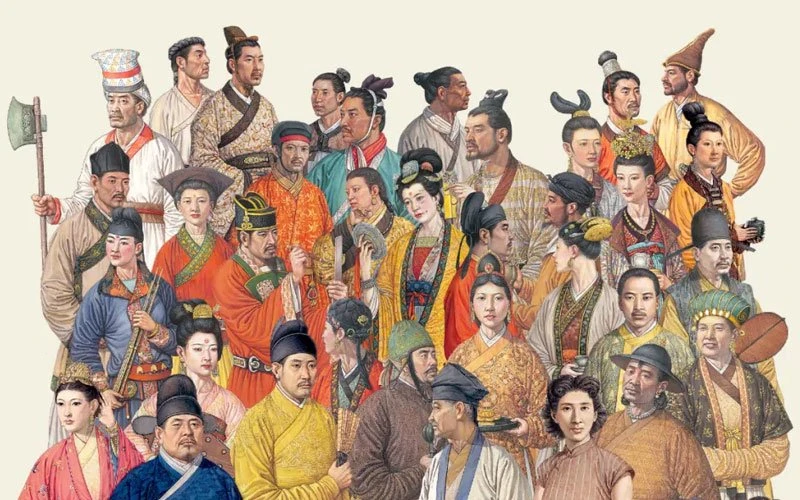
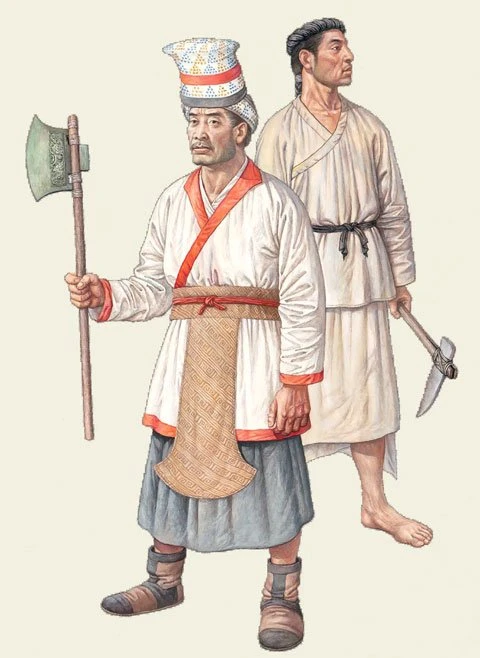
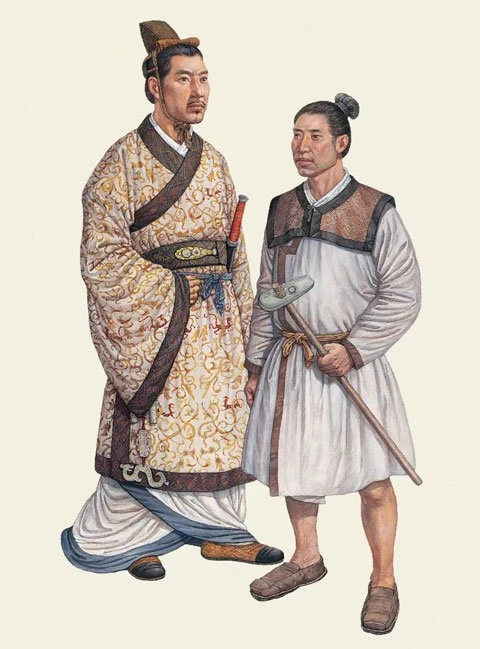
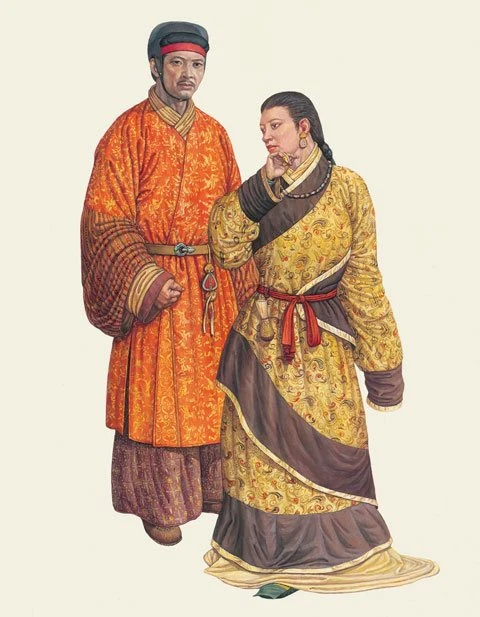
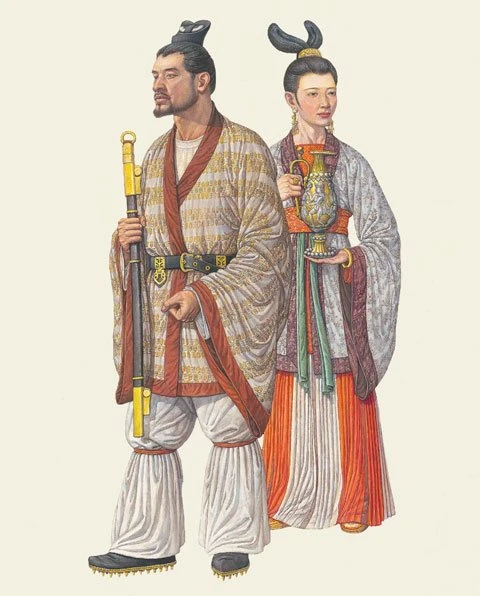
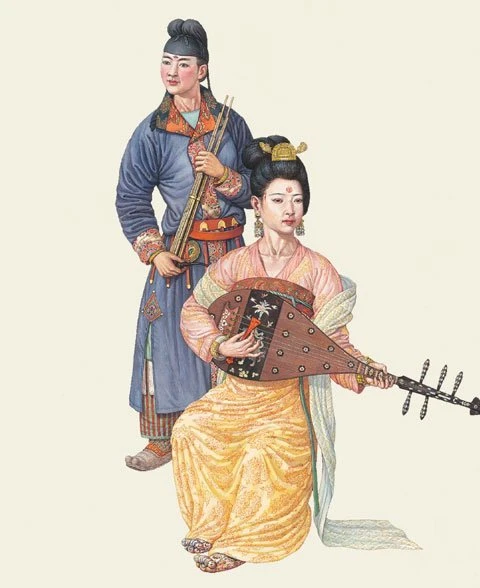
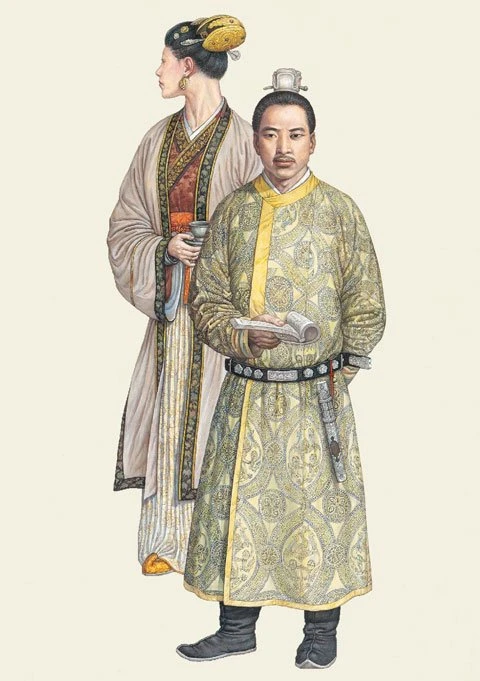
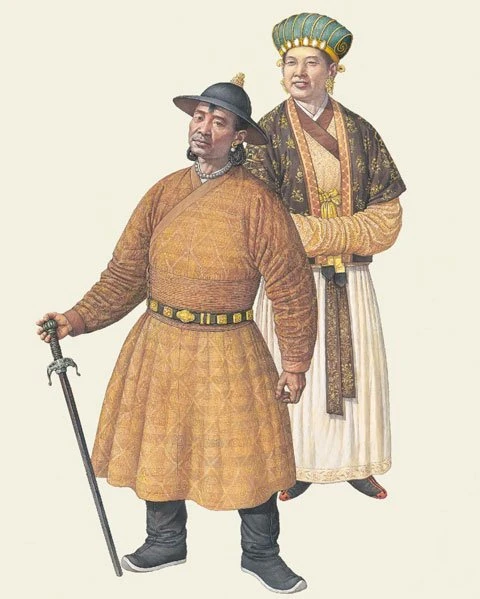
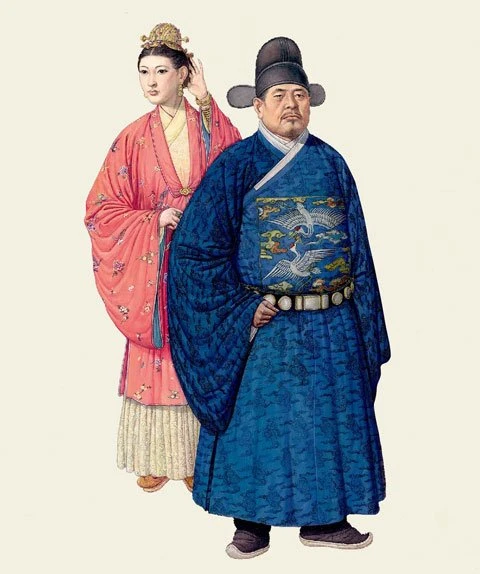
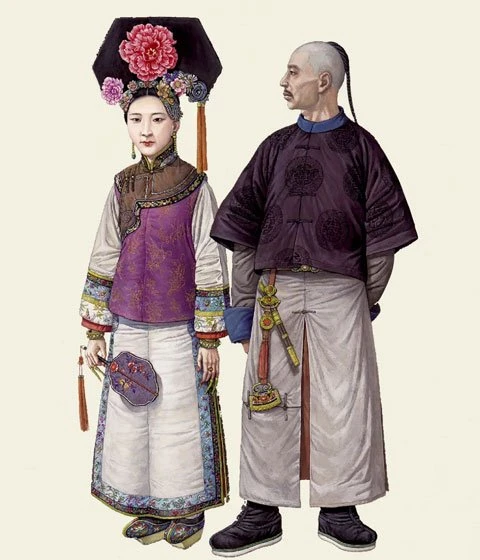
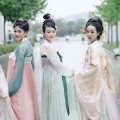

👍👍👍
What is "the collar around the false collar" on the male Qing Dynasty section?
Why are the lefts and rights flipped? 😂
This is a good artists but there are some wrong details in the illustrations making one wish the artist had made deeper investigation before drawing.
Common people in Shang wearing white clothes... how come? how did they discolor it& Usually dying white is a chemical process bad for skin and cloth durability. Natural color of hemp and ramie is brown (for that reason a later costume of undyed simple clothes was called /shuhe/ - dark/brown/ grey clothes )
The only natural white fibre apart from silk in Shang was wool. Even if you have enough wool (which is far more expensive than silk, Chinese weren't great sheep breeders), you would want to wear it all year round.
Also, textile colors did not cost much! During Shang they used moan, lan grass, rose madder and such which grew everywhere.
The other question HOW COME A PERSON OF 1000 BC is STANDING WITH NAKED LEGS?! There were no pants, so chang should be at least ankle-long. Such length of the top part, as far as I know, became available only during Warring States when crotched pants came into use.
This Chinese commoner looks more like Greek.
Hemp itself can have a few different colours, including off-white. Take account of linen, some of it had probably made its way to China. Textile colours may not cost much, but the technique could be inaccessible to some. About the leg, I do agree with your concern, but I found the picture of this artifact, from the Warring States period, have a look: